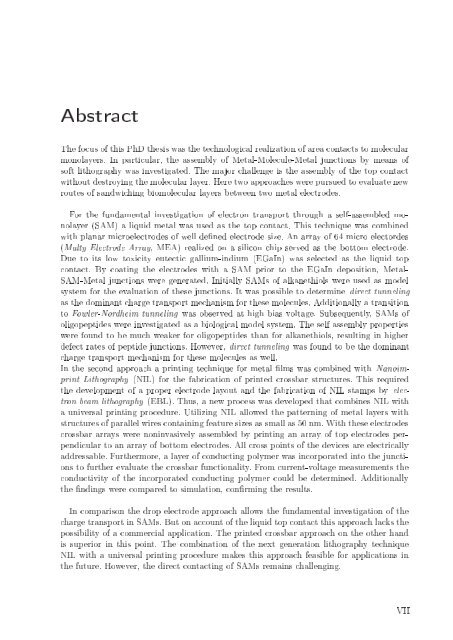View/Open - JUWEL - Forschungszentrum Jülich
View/Open - JUWEL - Forschungszentrum Jülich
View/Open - JUWEL - Forschungszentrum Jülich
Erfolgreiche ePaper selbst erstellen
Machen Sie aus Ihren PDF Publikationen ein blätterbares Flipbook mit unserer einzigartigen Google optimierten e-Paper Software.
Abstract<br />
The focus of this PhD thesis was the technological realization of area contacts to molecular<br />
monolayers. In particular, the assembly of Metal-Molecule-Metal junctions by means of<br />
soft lithography was investigated. The major challenge is the assembly of the top contact<br />
without destroying the molecular layer. Here two approaches were pursued to evaluate new<br />
routes of sandwiching biomolecular layers between two metal electrodes.<br />
For the fundamental investigation of electron transport through a self-assembled monolayer<br />
(SAM) a liquid metal was used as the top contact. This technique was combined<br />
with planar microelectrodes of well dened electrode size. An array of 64 micro electordes<br />
(Multy Electrode Array, MEA) realized on a silicon chip served as the bottom electrode.<br />
Due to its low toxicity eutectic gallium-indium (EGaIn) was selected as the liquid top<br />
contact. By coating the electrodes with a SAM prior to the EGaIn deposition, Metal-<br />
SAM-Metal junctions were generated. Initially SAMs of alkanethiols were used as model<br />
system for the evaluation of these junctions. It was possible to determine direct tunneling<br />
as the dominant charge transport mechanism for these molecules. Additionally a transition<br />
to Fowler-Nordheim tunneling was observed at high bias voltage. Subsequently, SAMs of<br />
oligopeptides were investigated as a biological model system. The self assembly properties<br />
were found to be much weaker for oligopeptides than for alkanethiols, resulting in higher<br />
defect rates of peptide junctions. However, direct tunneling was found to be the dominant<br />
charge transport mechanism for these molecules as well.<br />
In the second approach a printing technique for metal lms was combined with Nanoimprint<br />
Lithography (NIL) for the fabrication of printed crossbar structures. This required<br />
the development of a proper electrode layout and the fabrication of NIL stamps by electron<br />
beam lithography (EBL). Thus, a new process was developed that combines NIL with<br />
a universal printing procedure. Utilizing NIL allowed the patterning of metal layers with<br />
structures of parallel wires containing feature sizes as small as 50 nm. With these electrodes<br />
crossbar arrays were noninvasively assembled by printing an array of top electrodes perpendicular<br />
to an array of bottom electrodes. All cross points of the devices are electrically<br />
addressable. Furthermore, a layer of conducting polymer was incorporated into the junctions<br />
to further evaluate the crossbar functionality. From current-voltage measurements the<br />
conductivity of the incorporated conducting polymer could be determined. Additionally<br />
the ndings were compared to simulation, conrming the results.<br />
In comparison the drop electrode approach allows the fundamental investigation of the<br />
charge transport in SAMs. But on account of the liquid top contact this approach lacks the<br />
possibility of a commercial application. The printed crossbar approach on the other hand<br />
is superior in this point. The combination of the next generation lithography technique<br />
NIL with a universal printing procedure makes this approach feasible for applications in<br />
the future. However, the direct contacting of SAMs remains challenging.<br />
VII
















